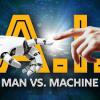
Breaking News
6.8 SPC vs. 300 Blackout: Powering Up the AR Platform
 Autism Study By McCullough Foundation Begins New Era of Free Scientific Inquiry
Autism Study By McCullough Foundation Begins New Era of Free Scientific Inquiry
 REVOLUTION DAY 8: Libertarians JOIN The Revolution
REVOLUTION DAY 8: Libertarians JOIN The Revolution
 US Government and Westinghouse $80bn Nuclear Reactor Deal
US Government and Westinghouse $80bn Nuclear Reactor Deal
Top Tech News
 Graphene Dream Becomes a Reality as Miracle Material Enters Production for Better Chips, Batteries
Graphene Dream Becomes a Reality as Miracle Material Enters Production for Better Chips, Batteries
 Virtual Fencing May Allow Thousands More Cattle to Be Ranched on Land Rather Than in Barns
Virtual Fencing May Allow Thousands More Cattle to Be Ranched on Land Rather Than in Barns
 Prominent Personalities Sign Letter Seeking Ban On 'Development Of Superintelligence'
Prominent Personalities Sign Letter Seeking Ban On 'Development Of Superintelligence'
 Why 'Mirror Life' Is Causing Some Genetic Scientists To Freak Out
Why 'Mirror Life' Is Causing Some Genetic Scientists To Freak Out
 Retina e-paper promises screens 'visually indistinguishable from reality'
Retina e-paper promises screens 'visually indistinguishable from reality'
 Scientists baffled as interstellar visitor appears to reverse thrust before vanishing behind the sun
Scientists baffled as interstellar visitor appears to reverse thrust before vanishing behind the sun
 Future of Satellite of Direct to Cellphone
Future of Satellite of Direct to Cellphone
 Amazon goes nuclear with new modular reactor plant
Amazon goes nuclear with new modular reactor plant
 China Is Making 800-Mile EV Batteries. Here's Why America Can't Have Them
China Is Making 800-Mile EV Batteries. Here's Why America Can't Have Them
Scientists pinpoint source of "impossible" EmDrive's thrust

NASA's findings replicated 2009 experiments in China. A zero-propellant thruster? The world sat up and listened.
The ability to generate thrust without having to carry the parasitic mass of fuel would be a game-changer in space, and even if the EmDrive's experimental thrust figures were small (720 millinewtons per 2.5 kW of input power in the 2009 Chinese experiment), they'd be several times more effective per weight and per watt of input than current ion propulsion systems, which need to carry fuel.
The trouble is, where ion drives are easily explained (a propellant is ionized, then electromagnetically thrown out the back of the thruster to push the vehicle forward), nobody could figure out how the EmDrive was producing Newtons while apparently disagreeing with Newton on the whole conservation of energy thing.
The inventor had a theory, but so did German scientists Martin Tajmar, Oliver Neunzig and Marcel Weikert, and the three have spent the last four years fine-tuning their experiments to prove it. In 2018, the team showed some weird results suggesting that the EmDrive's thrust didn't seem to be coming from the EmDrive itself, and they hypothesized that the results were possibly something to do with electromagnetic interference from the prototype's power cables interacting with the Earth's magnetic field.

 China Innovates: Transforming Sand into Paper
China Innovates: Transforming Sand into Paper

